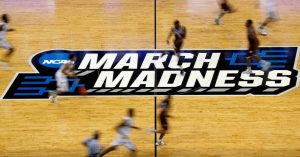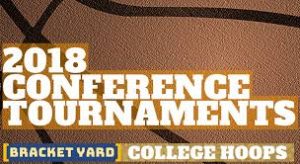College Conference Tournament Handicapping and Totals Situations
Madness Begins in March with College Conference Tournaments
The most exciting time of the college basketball season has arrived as the college conference tournaments (CCT’s) continue through selection Sunday March 11. While many fans and bettors anxiously await the NCAA Tournament brackets to be unveiled and the NCAA Tournament to begin in two weeks, the madness has already begun in March with the college conference tournaments. The final weekend of the regular season has some marquee match-ups that will decide regular season champions and be followed by postseason tournaments and the big  dance, NCAA Tournament. Also in play the final weekend of the regular season are big games with regular season conference titles at stake in the American Athletic, Big East, Big West, Ivy and SEC. The Big Ten started their conference tournament earlier this year playing at Madison Square Garden in New York to try and capture a bigger audience and East coast presence. The remaining power conferences will be playing college conference tournaments starting the week of March 5.
dance, NCAA Tournament. Also in play the final weekend of the regular season are big games with regular season conference titles at stake in the American Athletic, Big East, Big West, Ivy and SEC. The Big Ten started their conference tournament earlier this year playing at Madison Square Garden in New York to try and capture a bigger audience and East coast presence. The remaining power conferences will be playing college conference tournaments starting the week of March 5.
The college conference tournaments (CCT’s) provide another emotional situation to evaluate as players and teams push for an NCAA Tournament bid or other postseason tourney if they are not yet projected into the NCAA Tournament field. Other top of the conference teams jockey for position and a potential higher seed in the upcoming NCAA Tournament. So plenty of emotion and situations to evaluate, and as we saw in opening conference tournament action, plenty of underdogs are ready to give their best effort and upset some higher-seeded teams in conference tournaments.
In the Northeast Conference, which is not on the regular betting board during the regular season, both Robert Morris (+5) and Fairleigh Dickinson (+9) won outright to open CCT action Feb. 28, and we cashed in on these under the radar games. Big Ten ‘Dogs have started 5-1 ATS in CCT action and #14 seed Rutgers has won their first two games outright. Will the dream end against #3 seed Purdue in the  quarterfinals? Likely, but that’s what makes the CCT’s special, and even more so in the smaller conferences with just one NCAA Tournament bid available to the CCT champion.
quarterfinals? Likely, but that’s what makes the CCT’s special, and even more so in the smaller conferences with just one NCAA Tournament bid available to the CCT champion.
Regular season results mean much less as the college conference tournaments (CCT’s) play out, and with teams playing multiple games with zero days rest, the handicap and situations are much different as teams advance and intensity increases.
While scoring and possessions continue to rise with rules changes and reduction of shot clock in recent seasons, we often see a stronger effort on the defensive end of the court with more at stake in a one-and-done format. This is especially true as the stronger teams advance, as it’s often those teams that have proven to be better defensively during the course of the season. Playing multiple days in a row can also affect energy, and often shooting struggles can follow with less lift in the legs. Add in familiarity of playing these conference teams during the regular season, and quality coaches that know how to adjust and use a shorter bench, and we often see more defensive stops as coaches also know the opposing players and coaches tendencies.
 Coaching is always significant in college basketball, and you’ll find coaches having to ride the emotional roller coaster with their players as they push towards a NCAA bid, conference tournament championship or fall short and try to rebound in the NIT or other postseason tournament.
Coaching is always significant in college basketball, and you’ll find coaches having to ride the emotional roller coaster with their players as they push towards a NCAA bid, conference tournament championship or fall short and try to rebound in the NIT or other postseason tournament.
While the focus of these conference tournament games is often on the teams, betting lines and what’s at stake for the winners, it’s the totals that can provide an opportunity to cash in at the sports books as teams play back-to-back games and some 3 or 4 days in a row.
So here is some positive proof for totals bettors looking for a solid situation to support. We’re using the last two season’s results with the rules changes and shot clock reduction to 30 seconds. The NCAA’s goals of the rules changes and officiating points of emphasis were to  improve the pace of play, better balance offense with defense and reduce physicality to create freedom of movement on the court. It may not be better for the game overall, as the more athletic teams with deeper talent have a clear advantage over less talented opponents. So you need to be careful in your selection of big ‘Dogs when utilizing past profiles and situations that were successful, but may not be as effective in today’s game. The rules changes and specifically the shot clock reduction helped increase pace of play and scoring.
improve the pace of play, better balance offense with defense and reduce physicality to create freedom of movement on the court. It may not be better for the game overall, as the more athletic teams with deeper talent have a clear advantage over less talented opponents. So you need to be careful in your selection of big ‘Dogs when utilizing past profiles and situations that were successful, but may not be as effective in today’s game. The rules changes and specifically the shot clock reduction helped increase pace of play and scoring.
Total number of possessions increased from 65 to 70 following the rule changes and scoring increased from 67 to 73 points per game starting in 2015-16. Fouls were also up slightly increasing free throw attempts.
So here is what we are looking for in conference tournament play.
An underdog off a straight-up win playing with no rest (next day).
During the CCT’s of 2016, this base situation produced an over/under record of 11-15 (58%) using 17 top conference results. However, in conference championship games, the UNDER was 4-1. These games included Villanova over Seton Hall 69-67 (Big East), Buffalo over Akron 64-61 (MAC), Hawaii over Long Beach 64-60 (Big West), No. Iowa over Evansville 56-54 (Missouri Valley) and the only total OVER in Green Bay’s 78-69 win over Wright State (Horizon) in which both teams upset the top-2 seeds to reach the championship game.
A sub-situational profile to strengthen our base situation shows that if the game profile with our underdog winner shows both teams playing over the total in their previous game, then we have a stronger position playing under the total. That produced a 3-0 UNDER the total result in the 2016 championship games with all six teams in the Big East, MAC and Big West championship game playing semi-final games over the total.
It appears that with teams playing 3 or 4 straight days and able to reach the championship game off underdog wins, the energy level is unsustainable, which can lead to tired legs and perhaps less shooting strength. Clearly defensive focus is at its peak level in a championship game as well.
The 2017 CCT results for the power conferences produced these over/under results for teams off a SU underdog win (next game):
American: 2-0
A-10: 1-1
ACC: 1-2
Big 12: 1-2
Big East: 1-1
Big Ten: 2-0
Pac-12: 1-1
SEC: 2-1
11-8 over/under
In 2017 CCT championship games, the UNDER was 1-0 when a team entered the finals off a SU underdog win in the semi’s. These games included Duke over Notre Dame 75-69 (ACC).
With history as our guide and technical parameters in place that make some sense, look towards some of these totals situations and especially in the championship games of the college conference tournaments.
Article posted at osga.com.

 Twitter
Twitter Facebook
Facebook